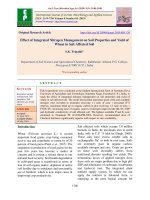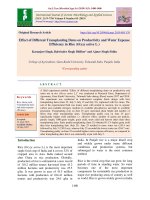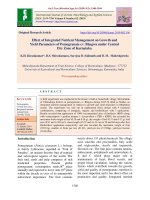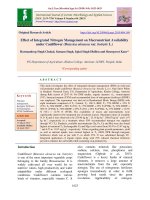Effect of integrated nitrogen management on rice and rice fallow rabi crops
Bạn đang xem bản rút gọn của tài liệu. Xem và tải ngay bản đầy đủ của tài liệu tại đây (322.59 KB, 10 trang )
Int.J.Curr.Microbiol.App.Sci (2019) 8(1): 271-280
International Journal of Current Microbiology and Applied Sciences
ISSN: 2319-7706 Volume 8 Number 01 (2019)
Journal homepage:
Original Research Article
/>
Effect of Integrated Nitrogen Management on Rice and
Rice Fallow Rabi Crops
M. Latha*, P. Ratna Prasad, P.R.K. Prasad, R. Lakshmipathy and V. Srinivasarao
Department of Soil Science & Agricultural Chemistry, Agricultural College, Bapatla- 522 101
Guntur Dt. Andhra Pradesh, India
*Corresponding author:
ABSTRACT
Keywords
INM, Rice, Rice fallow
cropping systems,
Yield of rice, Rice
fallow crops yield and
Yield attributes
Article Info
Accepted:
04 December 2018
Available Online:
10 January 2019
A field experiment was conducted at College Farm, Agricultural College, Bapatla
during 2015-16 and 2016-17 of both kharif and rabi seasons. The results of the
work indicated that the application of INM (Integrated nitrogen management) M 2
includes 50% RDN+ 25% N through FYM + 25% N through neem cake +
recommended dose of microbial consortium (Azospirillum + PSB @ 2.5kg ha-1)
recorded significantly higher grain yield and straw yield of rice over M 1 (100%
RDN) and residual effect of INM and 100% RDF (for each crop) gave higher
yields of blackgram, maize, sorghum, sunflower and mustard. Significantly 2530% higher yields were obtained in blackgram, maize, sorghum, sunflower and
mustard crops.
Introduction
Materials and Methods
Rice based cropping system is a predominant
cropping system in coastal Andhra Pradesh.
Complementary use of organic and biological
sources of plant nutrients along with chemical
fertilizer is of great importance for the
maintenance of soil health and productivity,
especially under intensive cropping system.
There is immense need to exploit the alternate
source of nutrients viz., organic manure, use
of legumes in crop rotation and biofertilizer to
sustain the productivity, soil health and soil
fertility with more environment friendly
nutrient management system.
A field experiment was conducted for two
consecutive years (2015-16 & 2016-17) on
clay loam soils of Agricultural College Farm,
Bapatla. The experiment was laid out in a two
sample t-test for rice in kharif season with 2
treatments and replicated thrice. The
treatments consists of M1 100% RDN, M2
(50% RDN + 25% N through FYM + 25% N
Through neem cake + Azopsirillum + PSB @
2.5 kg ha-1 (INM). During the immediate
kharif, the experiment was laid out in a split
plot design without disturbing the soil for
succeeding rabi crops with the two treatments
271
Int.J.Curr.Microbiol.App.Sci (2019) 8(1): 271-280
given to kharif rice as main plot treatments
and each of these divided into five sub-plots.
The experiment was repeated in another field
during kharif and rabi seasons. Popular
cultivars of rice (BPT 5204), blackgram (PU
31), maize (Sandhya), sorghum (NSH-54),
Sunflower (Shreshta) and Mustard (Konark)
were used for this study.
The soil is vertisol with bulk density (1.42 &
1.43), porosity (43.50 and 43.80%) and water
holding capacity (45.10 & 45.80%), slightly
alkaline in reaction, (pH 7.70 and 7.50), two
fields were non-saline in nature, cation
exchange capacity (35.4 & 37.2), medium
range of organic carbon (0.55 and 0.50%).
Low nitrogen content (266 and 250 kg ha-1),
available phosphorus was (59 and 53 kg ha-1)
and available potassium (630 and 668 kg ha-1).
The initial soil analysis data is presented in
table 1. The present investigation was
undertaken during 2015-16 and 2016-17 of
consecutive years.
The nutrients were applied through the
fertilizers like urea, single super phosphate,
muriate of potash. The farm yard manure and
neem cake was applied at seven days before
transplanting of rice on dry weight basis as per
the treatment. The bacterial inoculants applied
at the time of sowing as per recommended
dosage (Azospirillum + PSB @2.5 kg ha-1).
The nutrient content in applied organics was
given in the table 2 and 3 during first and
second year of study, respectively.
The recommended fertilizer doss were applied
as 120-40-40, 20-50-0, 200-60-50, 40-40-40,
60-60-30 and 60-60-40 kg N, P2O5 and K2O
ha-1 to rice, blackgram, maize, sorghum,
sunflower and mustard crops, respectively.
The soil samples were analysed as per
standard procedures for soil physical and
physico-chemical properties. Soil texture by
Piper, 1966, bulk density by Dastane, 1967,
water holding capacity by Sankaram, 1966,
soil reaction and EC by Jackson, 1973, CEC
by Bower et al., 1952 and organic carbon by
Walkley and Black, 1934. The data obtained
during kharif 2015-16 and 2016-17 were
analysed statistically using two sample t-test
analysis of variance (Panse and Sukhatme,
2000). The t-test value calculated for 12
replications and t-test value was 2.07. If the ttest value was >2.07, it was significant, while
<2.07 includes non-significant. Whereas the
data obtained during rabi 2015-16 and 201617 were analyzed statistically by following
split plot design as suggested by Gomez and
Gomez (1984). Wherever, the treatment
differences were found significant, critical
differences were worked out at five per cent
probability level and furnished along with
mean values of the parameter concerned in
tables. Treatmental differences that were nonsignificant were denoted by “NS”.
Results and Discussion
Effect of INM on yield of kharif rice
Rice yield is presented in table 4 indicated the
grain yield of rice during both the years of
study was significantly increased due to
application of INM over 100% RDN.
Application of organics along with 50% RDN
produced the highest grain yield (5818 kg
ha-1) which was superior over inorganics i.e.,
4473 kg ha-1 during 2015-16 and 5896 kg ha-1
superior over 100% RDF i.e., 4598 kg ha-1
during 2016-17 year. The increment of yield
with INM treatment was 30.0% and 28.22%
during first and second years, respectively.
Shanmugan and Veeraputhran (2001),
Bhattacharya et al., (2003) also reported
beneficial effects of FYM on yield of rice due
to better nutrition of crop. The effects of FYM
and neem cake were similar and significantly
increased the grain yield of rice over control.
Application of nutrients like neem cake,
different nitrogen levels and biofertilizers had
a significant and vital effect on yield and
quality attributes of crop.
272
Int.J.Curr.Microbiol.App.Sci (2019) 8(1): 271-280
Table.1 Initial properties of the experimental soil
Particulars
I. Physical properties
Mechanical composition
1. Sand (%)
2. Silt (%)
3. Clay (%)
Textural class
Bulk density (Mg m-3)
Porosity(%)
Water holding capacity (%)
II. Physico-chemical properties
pH (1:2.5)
2015-16
Field
No.13C
2016-17
Field
No.14C
42
20
38
Clay loam
1.44
43.50
45.10
40
21
39
Clay loam
1.43
43.80
45.80
7.70
7.50
0.26
EC (dS m-1)
35.4
Cation exchange capacity
(cmol (p+) kg-1)
0.55
Organic carbon (%)
III. Available nutrients
266
N (kg ha-1)
59
P2O5 (kg ha-1)
-1
630
K2O (kg ha )
IV. Secondary nutrients
Exchangeable Ca (cmol (p+) 23.39
kg-1)
Exchangeable Mg (cmol (p+) 5.80
kg-1)
15.00
SO4-2 - Sulphur (mg kg-1)
V. Available micro nutrients (mg kg-1)
27.50
Iron
5.50
Manganese
2.55
Zinc
0.59
Copper
VI. Biological properties
49.14
Dehydrogenase activity
-1
-1
(μg TPF g 24h )
Microbial populations
20.0
Bacteria count
(105 x cfu g-1 soil)
10.0
Fungi (103x cfu g-1 soil)
15.0
Actinomycetes
3
-1
(10 x cfu g soil)
273
Class/ Group
Clay loam
Normal
Normal
Normal
0.31
37.2
Neutral to slightly
alkaline in nature
Non-saline
Normal
0.50
medium
250
53
668
Low
High
Very high
24.07
Normal
5.70
Normal
15.50
Normal
25.00
4.90
2.65
0.65
Sufficient
Sufficient
Sufficient
Sufficient
39.15
Normal
25.0
Normal
8.0
15.0
Normal
Normal
Int.J.Curr.Microbiol.App.Sci (2019) 8(1): 271-280
Table.2 Nutrient content of organics applied during 1styear (2015-16)
Nutrient
C(%)
Total N (%)
Phosphorus (%)
Potassium (%)
Calcium (%)
Magnesium (%)
Sulphur (%)
Iron (ppm)
Manganese (ppm)
Copper (ppm)
Zinc (ppm)
C:N
FYM
25.8
0.616
0.24
0.41
0.88
1.20
0.32
11.72
0.534
0.074
0.11
41.8
Neem Cake
31.5
4.08
0.21
0.42
1.053
1.35
1.55
8.11
0.862
0.132
0.35
7.72
Table.3 Nutrient content of organics applied during 2ndyear (2016-17)
Nutrient
C(%)
Total N (%)
Phosphorus (%)
Potassium (%)
Calcium (%)
Magnesium (%)
Sulphur (%)
Iron (ppm)
Manganese (ppm)
Copper (ppm)
Zinc (ppm)
C:N
FYM
24.5
0.58
0.35
0.48
0.95
1.38
0.28
10.85
0.818
0.080
0.15
42.24
274
Neem Cake
29.8
4.89
0.42
0.43
1.02
1.45
1.05
8.15
0.755
0.115
0.78
6.09
Int.J.Curr.Microbiol.App.Sci (2019) 8(1): 271-280
Table.4 Effect of INM on yield attributes and yield of rice
Treatment
Productive
tillers m-2
M1:
100 %
RDN
M2: 50%
RDN+25% N FYM+ 25% N
- neem cake +
bacterial
consortium
t- value
2015-16
1000
Grain
Straw
seed
Yield
Yield
weight (kg ha-1) (kg ha-1)
(g)
14.3
4473
5607
Harvest
Index
(%)
Productive
tillers m-2
44.37
431
Filled
grains
per
panicle
132
2016-17
1000
Grain
Straw
seed
Yield
Yield
weight (kg ha-1) (kg ha-1)
(g)
14.5
4598
5657
421
Filled
grains
per
panicle
130
433
142
15.4
5818
6332
47.88
449
145
15.5
5896
6350
48.14
2.08
6.11
3.70
7.34
3.61
3.09
2.34
6.26
3.87
8.95
3.61
2.95
Table.5 Residual effect of INM on yield attributes and yield of blackgram
Treatment
100 seed
weight(g)
M1 : 100 % RDN
M2 : 50% RDN+25% N FYM+ 25% N - neem
cake + bacterial
consortium
t-value
2015-16
Haulm
Seed
yield
yield
(kg ha-1)
(kg ha-1)
Harvest
Index
(%)
100 seed
weight(g)
2016-17
Seed
Haulm
yield
yield
(kg ha-1)
(kg ha-1)
Harvest
Index
(%)
3.98
4.17
917
1118
1437
1528
38.95
42.25
4.55
4.91
1096
1210
1502
1615
42.18
42.83
9.76
14.10
5.15
2.15
8.11
4.75
12.85
2.07
275
Harve
st
Index
(%)
44.83
Int.J.Curr.Microbiol.App.Sci (2019) 8(1): 271-280
Table.6 Residual effect of INM on yield of maize
Treatment
100
kernel
weight(g)
M1 : 100 % RDN
M2 :50% RDN+25% N FYM+ 25%
Nneem cake + bacterial
consortium
t-value
2015-16
Kernel
Stover
yield
yield
(kg ha-1)
(kg ha-1)
Harvest
index
(%)
26.29
32.30
6326
7192
7411
8147
46.00
46.88
100
kernel
weight
(g)
27.96
31.81
6.72
5.25
7.11
2.15
2.25
2016-17
Kernel
Stover
yield
yield
(kg ha-1) (kg ha1
)
6100
7326
7682
8222
16.70
13.41
Harvest
index
(%)
45.43
48.30
3.11
Table.7 Residual effect of INM on yield and yield attributes of sorghum
Treatment
1000 grain
weight(g)
2015-16
Stover
Grain
yield
yield
-1
(kgha ) (kgha-)
6457
2612
Harvest
Index
( %)
28.80
1000
grain
weight(g)
24.75
2016-17
Stover
Grain
yield
yield
-1
(kg ha ) (kg ha-1)
5906
2850
Harvest Index
( %)
M1 : 100 % RDN
23.90
M2 : 50% RDN+25% N FYM+ 25% N - neem
cake + bacterial
consortium
tvalue
24.55
7127
3618
33.67
29.00
8325
3750
32.50
3.05
4.86
5.44
3.05
2.55
18.36
3.73
2.35
276
31.05
Int.J.Curr.Microbiol.App.Sci (2019) 8(1): 271-280
Table.8 Residual effect of INM on yield of sunflower
Treatment
1000 seed
weight(g)
2015-16
Stover
Seed yield
yield
(kg ha-1)
(kg ha-1)
M1 : 100 % RDN
M2 : 50% RDN+25%
N - FYM+ 25%
N - neem cake +
bacterial
consortium
32.5
42.0
2908
3159
1024
1507
26.04
32.30
1000
seed
weight
(g)
36.5
44.8
t-
2.15
2.08
17.14
4.55
3.08
value
Harvest
index
(%)
2016-17
Seed yield
(kg ha-1)
Harvest index
(%)
Stover
yield
(kg ha-1)
2712
3177
1125
1780
29.32
35.90
6.61
3.69
3.11
Table.9 Residual effect of INM on yield of mustard
Treatment
M1 : 100 % RDN
M2 : 50% RDN+25% N FYM+ 25% N - neem
cake + bacterial
consortium
t - value
2015-16
2016-17
1000 seed
weight(g)
4.05
Stover yield
(kg ha-1)
1515
Seed yield
(kg ha-1)
815
Harvest
index(%)
34.97
1000 seed
weight(g)
4.26
Stover yield
(kg ha-1)
1619
Seed yield
(kg ha-1)
915
Harvest
index(%)
36.10
4.26
1805
1025
36.21
4.55
1695
1135
40.10
2.11
2.09
9.45
2.55
3.08
2.13
13.34
2.15
277
Int.J.Curr.Microbiol.App.Sci (2019) 8(1): 271-280
application of inorganic fertilizers @ 50%
RDN+25% N through FYM + 25% N through
neem cake + recommended dose of bacterial
inoculants to the preceding rice crop. The
increase might be a result of improvement in
soil properties in terms of soil, which
reflected on increasing biological yield as
reported by Kachapur et al., (2001).
Residual effect of INM on yields of rabi
crops
Seed yield of blackgram is presented in table
5. Significantly higher seed yield was
obtained in residual effect of M2 treatment
with values of 1118 and 1210 kg ha-1 in the
year 2015-16 and 2016-17, respectively.
These yields were higher by 21.9% and
10.40% over M1 during first and second
years, respectively, which indicated the
residual effect of INM treatment (M2)
imposed in rice during kharif. Similar results
were obtained by Gajendrasingh et al., (2016)
who reported that INM had showed the
highest seed yield compared to inorganics
only.
Significantly higher grain yields of sunflower
were noticed in residual effect of M2
treatment. The increase of 47.16% was
obtained during first year and 58.2% during
second year. Higher biomass production and
large canopy spread would have induced the
optimally fertilized plants to the increase in
seed yield commensurate with large nutrient
concentration in seed. Gudade et al., (2011)
reported that the seed yield obtained under
100% RDF + organics was significantly
higher than 50% and 100% RDF. Application
of integrated nitrogen management to rice
increased the stover yield of sunflower by
251(8.63%) and 465 (17.14%) compared with
M1 in first and second years, respectively.
The stover yield was increased from 2908 kg
ha-1 to 3159 kg ha-1 during the year 2015-16
and it was increased from 2712 kg ha-1 to
3177 kg ha-1 during 2016-17. The yield of
sunflower is represented in table 8. The
increase in stover yield might be due to the
fact that the applied FYM released the
nutrients were in close conformity with the
findings of Nanjudappa et al., (2001) and the
applied FYM released the nutrients in
adequate amount in the following season also.
Residual effect of INM to rice increased the
kernel yield of maize by 866 and 1582 kg ha-1
compared with 100% RDN (M1) in first and
second years, respectively. The maize grain
yield is represented in table 6. The kernel
yield was obtained 7192 kg ha-1 during 201516 and 7682 kg ha-1 in M2 during 2016-17
year. These results were in line with findings
of Singh et al.(2000). Experiments performed
by Negassa et al., (2001) exhibited that there
was significant residual effects of FYM which
influenced maize grain yields.
The increase of 38.5% was obtained during
2015-16 and 31.5% during 2016-17 in M2
over M1 of sorghum grain yield. The sorghum
yield is represented in table 7. The grain yield
of sorghum significantly improved with the
application of INM. Organic and inorganic
fertilizers are an efficient exogenous source of
plant nutrients. When fertilizers are used as
balanced
fertilizer
use,
along
with
complementary use of organic and bio
sources can help reverse environmental
degradation by providing much needed
nutrients to the soil, thereby increasing crop
yields (Sudhanshu, 2013). The stover yield of
sorghum significantly improved with the
Significantly higher seed yields of mustard
was noticed in residual effect of M2 treatment.
The increase of 25% was obtained during
2015-16 and 24% during 2016-17. The
mustard seed yield is represented in table 9.
Similar results were found by Sonam Lecha,
2015. Thaneswar et al., (2017) exhibited that
integrated application of 100% RDF along
with vermicompost @ 5t/ha obtained higher
278
Int.J.Curr.Microbiol.App.Sci (2019) 8(1): 271-280
seed yield. Combination of organic and
inorganic fertilizers was an efficient
exogenous source of plant nutrients. When
fertilizers were used insufficient and
imbalanced, balanced fertilizer use, along
with complementary use of organic and bio
sources can helped reverse environmental
degradation by providing much needed
nutrients to the soil, thereby increasing crop
yields (Sudhanshu, 2013). Application of
integrated nitrogen management to rice
increased the stover yield of mustard by 290
kg ha-1 and 76 kg ha-1 compared with NPK
alone treatment (M1) in first and second years,
respectively.
yield of transplanted summer rice.
Environment and ecology, 21(3): 680683.
Bower, C.A., Reitemeier, R.F and Fireman,
M. 1952. Exchangeable cations analysis
of saline and alkali soils. Soil Science,
73: 251-261.
Dastane, N.G., 1967. A Practical Manual for
water use research, Navabharat,
Prakashan Publication, Poona (India),
120.
Gajendra Singh, Pushkar Choudhary, Bharat
Lal Meena, Rajveer Singh Rawat and
Bhanwar lal Jat, 2016. Integrated
nutrient management in Blackgram
under rainfed condition. International
Journal of Recent Scientific Research,
7(10): 13875-13894.
Gomez, K. A and Gomez, A.A. 1984.
Randomized Block Design in Statistical
Procedure for Agricultural Research.
Published by a Wiley Inter Science,
USA: 621-635.
Gudadhe, N.N., Khnag, V.T., Thete, N.M.,
Lambade, B.M and Jibhkate, S.B. 2011.
Studies on organic and inorganic
sources of nutrient application in
cotton- chickpea cropping sequence,
Omonrice, 18:121-128.
Jackson, M.L. 1973. Soil chemical analysis.
Prentice Hall of India Private Ltd., New
Delhi. 134-182.
Kachapur, M. D., Roodagi, L. I and Chittapur,
B. N. 2001. Influence of vermicompost
on the productivity of sorghum.
Karnataka Journal of Agricultural
Science, 14(3): 779-780.
Nanjundappa, G., Shivaraj, B., Janarjuna, S
and Sridhara, S. 2001. Effect of organic
and inorganic sources of nutrients
applied alone or in combination on
growth and yield of sunflower. Helia,
24(34):115-120.
Negassa, W., Negisho, K., Friesen, D. K.
Ransom, J and Yadessa, A. 2001.
Determination of optimum farm yard
In conclusion, plant height, dry matter yield,
yield attributes, grain yield and straw yield of
rice were recorded significantly higher in the
treatment of M2(50% RDN+ 25% N through
FYM+ 25% N through neem cake +
Azospirillum and PSB @ 2.5kg ha-1). The
increment of yield with INM treatment was
30.0% and 28.22% during 2015-16 and 201617 years, respectively. Growing of succeeding
rabi crops on yield attributes and yield were
significantly influenced by the INM which
imposed to preceding rice crop. Plant height,
dry matter yield, yield attributes, grain yield,
stover yield, test weight and harvest index of
rabi crops (blackgram, maize, sorghum,
sunflower and mustard) recorded highest in
all those plots, which received organics along
with 50% RDN+ Azospirillum and PSB @
2.5kg ha-1 to preceding rice were more than
those received 100% RDN alone. Application
of INM to preceding rice crop, increased the
all rabi crop yields by 25-30% when
compared to M1.
References
Bhattacharya,
S.P.,
Sitangshu,
S.,
Karimadkar, A.J., Bera, P.S., Lalitha,
M., Sarkar, S and Mandal, L. 2003.
Effects of humic acid on the growth and
279
Int.J.Curr.Microbiol.App.Sci (2019) 8(1): 271-280
manure and NP fertilizers for maize on
farmers fields. Seventh Eastern and
Southern Africa Regional Maize
Conference, 387-393.
Panse, V. G and Sukhatme, P. V. 2000.
Statistical methods for Agricultural
workers. Published by ICAR, New
Delhi.
Piper, C. S. 1966. Soil and plant analysis.
Hans Publishers, Bombay: 368.
Sankaram, A. 1966. A laboratory manual for
agricultural chemistry. Asia publishing
House. Bombay. 41-149.
Shanmugam,M and Veeraputhran, R 2001.
Effect of organic manure, biofertilizers,
inorganic nitrogen and Zn on growth
and yield of rabi rice. Madras
Agricultural Journal. 87(1/3):90-93.
Singh, A.K., Amgain, L.P and Sharma, S.K.
2000. Root characteristics, soil physical
properties and yield of rice as
influenced by INM in rice-wheat
system. Indian Journal of Agronomy,
45(2): 217-222.
Sonam Lepcha, Moinuddin, D. R and
Kriteshna Bhejel. 2015. Influence of
different organic and inorganic sources
of nitrogen on growth, yield and oil
content of Indian mustard. Journal of
international Academic Research for
multidisciplinary. 3(11).
Sudhanshu, S. K. 2013. Effect of in-situ soil
moisture conservation practices and
different nitrogen sources on rain fed
sorghum
(Sorghum
biocolor
L.
Moensh) and soil properties Ph.D.
Thesis Andhra Pradesh, Acharya N. G.
Ranga
Agricultural
University,
Hyderabad, Rajendranagar.
Thaneswar Vishram Singh, Jai Prakash,
Manoj Kumar, Ateesh Kumar, S and
Singh, R. K. 2017. Effect of integrated
nutrient management on growth and
yield of mustard in irrigated condition
of Upper Gangetic plain zone of India.
International Journal of Current
Microbiology and Applied Sciences.
6(1): 922-932.
Walkley, A. Black, A. 1934. An Examination
of degtjareff, method for determining
soil organic matter and a proposed
modification of the chromic acid
titration method. Soil Science. 37: 2938.
How to cite this article:
Latha, M., P. Ratna Prasad, P.R.K. Prasad, R. Lakshmipathy and Srinivasarao, V. 2019. Effect
of Integrated Nitrogen Management on Rice and Rice Fallow Rabi Crops.
Int.J.Curr.Microbiol.App.Sci. 8(01): 271-280. doi: />
280








![Effect of integrated nutrient management and bio-regulators on quality attributes of sprouting broccoli [Brassica oleracea (L.) Var. Italica Plenck] effect of Integrated Nutrient Management](https://media.store123doc.com/images/document/2020_01/14/medium_ldn1578943904.jpg)
